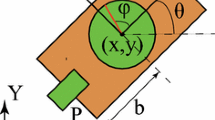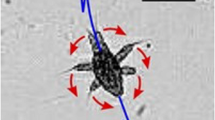Abstract
This paper presents a tool for analyzing the motion of two-link nonholonomic swimmers. We refer to these systems as Land-sharks, which are a generalization of the well known Roller Racers. By exploiting the symmetry of the system, we are able to reduce the equations of motion and construct the scaled momentum evolution equation. This unveils a very useful and intuitive Land-shark motion analysis tool based on the partitioning of the mass and geometry parameter space. In particular, this partitioning reveals that, as opposed to the Roller Racer, the Land-shark’s momentum can be increased and decreased, i.e., the system can be stopped. This is done through the use of steering, which is the system’s only input. Furthermore, we explore the problem of modeling frictional slip by assessing the applicability of a previously proposed friction model to the oscillatory locomotion of the Land-shark. Results show that the proposed friction model is generally applicable to two-link nonholonomic mechanical systems, which is an important step toward establishing the generality of the friction model for nonholonomic mechanical systems.






Similar content being viewed by others
References
Ostrowski, J.: The Mechanics of Control of Undulatory Robotic Locomotion. Ph.D. thesis, California Institute of Technology (1995)
Hirose, S., Morishima, A.: Design and control of a mobile robot with an articulated body. Int. J. Robot. Res. 9(2), 99–114 (1990)
Lewis, A.D., Ostrowski, J.P., Murray, R.M., Burdick, J.W.: Nonholonomic mechanics and locomotion: the snakeboard example. In: Proceedings of IEEE International Conference on Robotics and Automation, pp. 2391–2397. San Diego, CA (1994)
Kelly, S.D., Fairchild, M., Hassing, P., Tallapragada, P.: Proportional heading control for planar navigation: the Chaplygin Beanie and fishlike robotic swimming. In: American Control Conference (2012)
Krishnaprasad, P.S., Tsakiris, D.: Oscillations, SE(2)-snakes and motion control. In: Proceedings of the 34th IEEE Conference on Decision and Control, vol. 3, pp. 2806–72811 (1995)
Jouffroy, G.: Evaluating adaptive oscillatory neural network controllers using a simple vehicle model. In: IEEE International Conference on Robotics and Biomimetics, ROBIO 2006, 1670–171675 (2006)
Jouffroy, G., Jouffroy, J.: A simple mechanical system for studying adaptive oscillatory neural networks. In: IEEE International Conference on Systems, Man and Cybernetics, SMC 2006, vol. 3, pp. 2584–72589 (2006)
Bullo, F., Zefran, M.: On mechanical control systems with nonholonomic constraints and symmetries. In: Proceedings of the 2002 IEEE International Conference on Robotics and Automation, ICRA 2002, vol. 2, pp. 1741–71746 (2002)
Lewis, A.: Simple mechanical control systems with constraints. IEEE Trans. Autom. Control 45(8), 1420–71436 (2000)
Chitta, S., Cheng, P., Frazzoli, E., Kumar, V.: RoboTrikke: a novel undulatory locomotion system. In: Proceedings of the 2005 IEEE International Conference on Robotics and Automation, ICRA 2005, pp. 159717–1602 (2005)
Bazzi, S., Shammas, E., Asmar, D.: A novel method for modeling skidding for systems with nonholonomic constraints. Nonlinear Dyn. 76(2), 1517–1528 (2014)
Sidek, N., Sarkar, N.: Dynamic modeling and control of nonholonomic mobile robot with lateral slip. Third International Conference on Systems, ICONS 2008, pp. 35–40 (2008)
Shammas, E.A.: Generalized motion planning for underactuated mechanical systems. Ph.D. thesis, Carnegie Mellon University (2006)
Shammas, E.A., Choset, H., Rizzi, A.A.: Motion planning for dynamic variable inertia mechanical systems with non-holonomic constraints. In: International Workshop on the Algorithmic Foundations of Robotics, WAFR (2006)
O’Reilly, O.M.: The dynamics of rolling disks and sliding disks. Nonlinear Dyn. 10(3), 287–305 (1996)
Udwadia, F.E., Kalaba, R.E., Phohomsiri, P.: Mechanical systems with nonideal constraints: explicit equations without the use of generalized inverses. J. Appl. Mech. 71, 61517620 (2004)
Dear, T., Kelly, S.D., Travers, M., Choset, H.: Mechanics and control of a terrestrial vehicle exploiting a nonholonomic constraint for fishlike motion. In: Proceedings of the ASME 2013 Dynamic Systems and Control Conference, DSCC 2013, October (2013)
Bakker E., Nyborg L., Pacejka H.B.: Tire modeling for the use of the vehicle dynamics studies, SAE Paper, 870421 (1987)
Bloch, A.M., Krishnaprasad, P.S., Marsden, J.E., Murray, R.M.: Nonholonomic mechanical systems with symmetry. Arch. Ration. Mech. Anal. 136, 21–99 (1996)
Kelly, S.D., Murray, R.M.: The geometry and control of dissipative systems. In: Proceedings of the 35th IEEE Conference on Decision and Control, pp. 981-986 (1996)
Ostrowski, J.: Reduced equations for nonholonomic mechanical systems with dissipative forces. Rep. Math. Phys. 42(1), 185–209 (1998)
Dear, T., Kelly, S.D., Travers, M., Choset, H.: Snakeboard motion planning with viscous friction and skidding. In: Proceedings of IEEE International Conference on Robotics and Automation (ICRA), pp. 670–675 (2015)
Shammas, E., Asmar, D.: Motion planning for an underactuated planar robot in a viscous environment. J. Comput. Nonlinear Dyn. 10(5), 051002 (2015)
Acknowledgements
This work is supported by the Lebanese National Council for Scientific Research (LNCSR), the University Research Board (URB) of the American University of Beirut, and the Munib and Angela Masri Institute. The authors would like to thank the reviewers for their insightful comments, which helped in improving the work presented in this paper.
Author information
Authors and Affiliations
Corresponding author
Electronic supplementary material
Below is the link to the electronic supplementary material.
Supplementary material 1 (mp4 3494 KB)
Appendices
Appendix
A Proofs of Lemmas
A.1 Proof of Lemma 1
Proof
(always holds since masses and lengths are positive).
(never holds since masses and lengths are positive).
\(\square \)
A.2 Proof of Lemma 2
Proof
(never holds since masses and lengths are positive).
(always holds since masses and lengths are positive). \(\square \)
A.3 Proof of Lemma 3
Proof
(never holds since masses and lengths are positive).
(always holds since masses and lengths are positive).
(always holds since masses and lengths are positive).
(never holds since masses and lengths are positive). \(\square \)
Rights and permissions
About this article
Cite this article
Bazzi, S., Shammas, E., Asmar, D. et al. Motion analysis of two-link nonholonomic swimmers. Nonlinear Dyn 89, 2739–2751 (2017). https://doi.org/10.1007/s11071-017-3622-y
Received:
Accepted:
Published:
Issue Date:
DOI: https://doi.org/10.1007/s11071-017-3622-y




